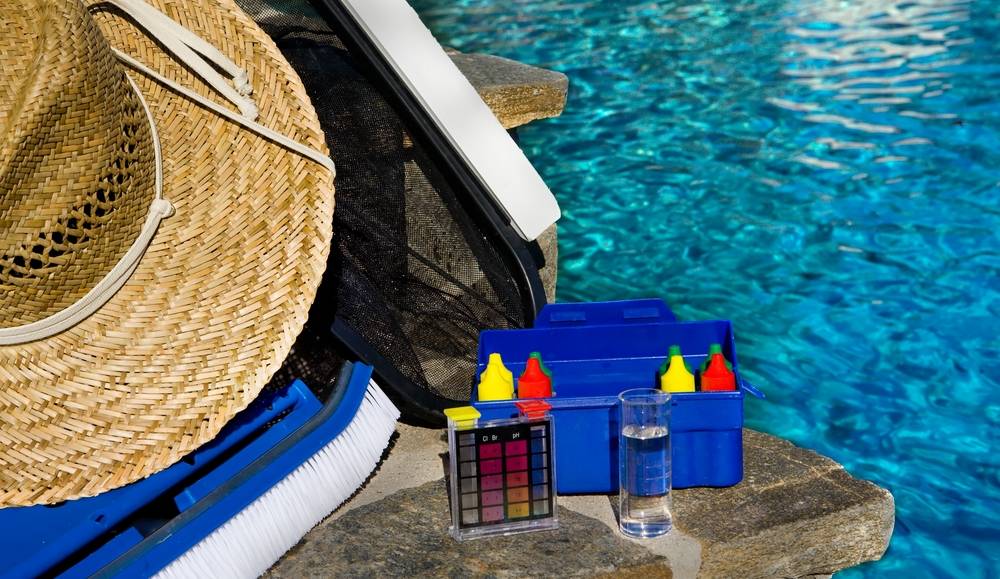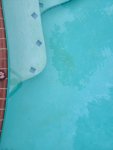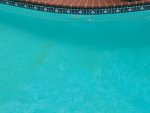Yellow silt like deposits
- Thread starter cchaynes
- Start date
You are using an out of date browser. It may not display this or other websites correctly.
You should upgrade or use an alternative browser.
You should upgrade or use an alternative browser.
Wobblerlorri
Bronze Supporter
- Apr 16, 2019
- 2,010
- Pool Size
- 4024
- Surface
- Vinyl
- Chlorine
- Liquid Chlorine
Mustard algae alright. SLAM time. Don't forget the mustard algae treatment after the SLAM is done!
I went with a less agressivne approach.
1) vac pool to waste
2) balance ph
3) add yellow treat (Yellow Treat® | United Chemical)
4) Super chlorinate with liquid chlorine (2-2.5 gal for 20,000 gal pool)
Cleared up almost in an hour
5) backwash DE filter
6) shock again as above
Results are good, it struggled to establish a chlorine level but issued dichlor shock for a third shock on day 3 and it took.
Hope this helps anyone who is looking to address this.
Pool water was in the 60-70 degree range as I turned the eater off and it was cold.
1) vac pool to waste
2) balance ph
3) add yellow treat (Yellow Treat® | United Chemical)
4) Super chlorinate with liquid chlorine (2-2.5 gal for 20,000 gal pool)
Cleared up almost in an hour
5) backwash DE filter
6) shock again as above
Results are good, it struggled to establish a chlorine level but issued dichlor shock for a third shock on day 3 and it took.
Hope this helps anyone who is looking to address this.
Pool water was in the 60-70 degree range as I turned the eater off and it was cold.
Sodium bromide is not a good choice for pools. It makes the pool a bromine pool for a while.
This "less aggressive" approach is actually likely to be far more aggressive and potentially damaging long-term.
I suggest anybody seeking information on a similar issue who happens upon this post to please start your own post asking for assistance. Following the advice posted by OP is not a very good way to deal with the problem. It is unlikely to be a lasting fix but will cause some potentially long-lasting problems that will only be correctable by water exchange.
I suggest anybody seeking information on a similar issue who happens upon this post to please start your own post asking for assistance. Following the advice posted by OP is not a very good way to deal with the problem. It is unlikely to be a lasting fix but will cause some potentially long-lasting problems that will only be correctable by water exchange.
Interesting, can you elaborate on what/why this approach will not work? Yellow Treat has a long track record with mostly positive reviews.This "less aggressive" approach is actually likely to be far more aggressive and potentially damaging long-term.
I suggest anybody seeking information on a similar issue who happens upon this post to please start your own post asking for assistance. Following the advice posted by OP is not a very good way to deal with the problem. It is unlikely to be a lasting fix but will cause some potentially long-lasting problems that will only be correctable by water exchange.
You convert the pool to bromine and the CYA is no longer effective, which means that the chlorine added will quickly get lost to converting bromide into bromine and the bromine will be lost to sunlight.
The pool is perfect, CYA is in check, holds a solid FC level, perhaps if someone overused this product, then what is being said here is true and I appreciate the warning, but if used in accordance with the directions, seems to do the trick. That said, a slam isn't that much more work, so it seems like a good option too, and if the issue returns, what I will do.
What exactly are you numbers and how are you testing to get them? How do you chlorinate your water?
What do you feel the sodium bromide did to your water that would cause this problem to go away?
What do you mean when you say "the pool is perfect"?
Why do you feel it is safe to use sodium bromide "in accordance with the directions" and what constitutes "overuse" to you?
How are you sure that, of all the steps you took, it was specifically the sodium bromide that fixed the issues you were having?
Finally: how do you know the issues are actually fixed and not just temporarily hidden?
What do you feel the sodium bromide did to your water that would cause this problem to go away?
What do you mean when you say "the pool is perfect"?
Why do you feel it is safe to use sodium bromide "in accordance with the directions" and what constitutes "overuse" to you?
How are you sure that, of all the steps you took, it was specifically the sodium bromide that fixed the issues you were having?
Finally: how do you know the issues are actually fixed and not just temporarily hidden?
What exactly are you numbers and how are you testing to get them? How do you chlorinate your water?
During the process I used liquid chlorine, usually, I float pucks and shock with Dichlor. Testing is with strips, they almost always agree with a test at the pool shop.
What do you feel the sodium bromide did to your water that would cause this problem to go away?
It temporarily converts to bromine which is effective at killing the algae in question, ait then goes to a zero chlorine/bromine and a heavy shock restores the chlorine residual.
What do you mean when you say "the pool is perfect"?
It tests well and looks perfect
Why do you feel it is safe to use sodium bromide "in accordance with the directions" and what constitutes "overuse" to you?
Because it is proven to work and the product has been sold since 1983, I used the correct amount, as I understand it, more is not more with this process.
How are you sure that, of all the steps you took, it was specifically the sodium bromide that fixed the issues you were having?
Because I had recently done the rest of the steps with shock and a filter recharge and it didn't go away, with this product it was nearly instant.
Finally: how do you know the issues are actually fixed and not just temporarily hidden?
Who is to say I guess, but all evidence so far is that the problem is gone, in addition, the pool will be closed soon so that is good enough for me!
Like anything there are always multiple approaches that can be taken, perhaps my issue was small enough for this to work, and perhaps it will be back, and if that is the case I will update this thread.
During the process I used liquid chlorine, usually, I float pucks and shock with Dichlor. Testing is with strips, they almost always agree with a test at the pool shop.
What do you feel the sodium bromide did to your water that would cause this problem to go away?
It temporarily converts to bromine which is effective at killing the algae in question, ait then goes to a zero chlorine/bromine and a heavy shock restores the chlorine residual.
What do you mean when you say "the pool is perfect"?
It tests well and looks perfect
Why do you feel it is safe to use sodium bromide "in accordance with the directions" and what constitutes "overuse" to you?
Because it is proven to work and the product has been sold since 1983, I used the correct amount, as I understand it, more is not more with this process.
How are you sure that, of all the steps you took, it was specifically the sodium bromide that fixed the issues you were having?
Because I had recently done the rest of the steps with shock and a filter recharge and it didn't go away, with this product it was nearly instant.
Finally: how do you know the issues are actually fixed and not just temporarily hidden?
Who is to say I guess, but all evidence so far is that the problem is gone, in addition, the pool will be closed soon so that is good enough for me!
Like anything there are always multiple approaches that can be taken, perhaps my issue was small enough for this to work, and perhaps it will be back, and if that is the case I will update this thread.
And that was what? I don't think that your response will be found to be helpful to others as is...Thank you, you definitely told me what I needed to know.
- Apr 10, 2018
- 5,138
- Pool Size
- 18375
- Surface
- Plaster
- Chlorine
- Salt Water Generator
- SWG Type
- CircuPool RJ-45
In the event @Donldson checked out, I'm sure he was referring to the unreliability of test strips and pool store testing. Both have proven to be inaccurate and inconsistent. Best bet is to invest in a good test kit (TF-100 or Taylor K-2006c) and do your own testing.Testing is with strips, they almost always agree with a test at the pool shop.
Best wishes...
ThanksIn the event @Donldson checked out, I'm sure he was referring to the unreliability of test strips and pool store testing. Both have proven to be inaccurate and inconsistent. Best bet is to invest in a good test kit (TF-100 or Taylor K-2006c) and do your own testing.
Best wishes...
is there a difference between these? besides price?
Amazon.com : Taylor Service Complete Pool Water Test Kit K-2006C : Swimming Pool Liquid Test Kits : Garden & Outdoor
Amazon.com : Taylor Service Complete Pool Water Test Kit K-2006C : Swimming Pool Liquid Test Kits : Garden & Outdoor
www.amazon.com
Amazon.com : TAYLOR TECHNOLOGIES INC K-2006 TEST KIT COMP CHLORINE FAS-DPD : Swimming Pool Liquid Test Kits : Garden & Outdoor
Amazon.com : TAYLOR TECHNOLOGIES INC K-2006 TEST KIT COMP CHLORINE FAS-DPD : Swimming Pool Liquid Test Kits : Garden & Outdoor
www.amazon.com
- Apr 10, 2018
- 5,138
- Pool Size
- 18375
- Surface
- Plaster
- Chlorine
- Salt Water Generator
- SWG Type
- CircuPool RJ-45
Check out the article below. The 2006C provides more of each reagent. If I was a pool guy working on several pools, I would go with the Taylor kit. The TF-100 is the best value for a residential pool owner.

 www.troublefreepool.com
www.troublefreepool.com

Swimming Pool Test Kits Compared
What pool test kit should I buy? Why not use test strips? Our recommended test kits will pay for themselves in no time!
Wobblerlorri
Bronze Supporter
- Apr 16, 2019
- 2,010
- Pool Size
- 4024
- Surface
- Vinyl
- Chlorine
- Liquid Chlorine
2006C has more reagents. The TF-100 (link in my sig) is less expensive and has more of the reagents you actually use the most.
I understood @Donldson perfectly. Your pool is not in any way a TFP pool. You use pucks and the occasional bag of shock. You use test strips and test at the pool store. By inference, your CYA is likely sky-high and you probably have a greatly lowered efficacy of your chlorine as a result. No wonder you keep algae.
If you'll read ABCs of Pool Water Chemistry and browse Pool School, you'll see what the TFP method is all about and why we challenged your algae removal method. Ah well, there's always next season. I recommend doing the reading and giving our method a try next year. You've got nothing to lose and everything to gain, especially money in your pocket.
I understood @Donldson perfectly. Your pool is not in any way a TFP pool. You use pucks and the occasional bag of shock. You use test strips and test at the pool store. By inference, your CYA is likely sky-high and you probably have a greatly lowered efficacy of your chlorine as a result. No wonder you keep algae.
If you'll read ABCs of Pool Water Chemistry and browse Pool School, you'll see what the TFP method is all about and why we challenged your algae removal method. Ah well, there's always next season. I recommend doing the reading and giving our method a try next year. You've got nothing to lose and everything to gain, especially money in your pocket.
Next year the plan is to add a salt cell, so it will be a much different setup. I ordered the tf-100.
- Apr 10, 2018
- 5,138
- Pool Size
- 18375
- Surface
- Plaster
- Chlorine
- Salt Water Generator
- SWG Type
- CircuPool RJ-45
Good move cc! FYI, the TF-100 doesn't come with a salt test kit. The Taylor K-1766 test kit is recommended by TFP. The salt kit will get you into free shipping territory if you decide to get the salt test kit now. I'm sure they can edit your order.
Thread Status
Hello , This thread has been inactive for over 60 days. New postings here are unlikely to be seen or responded to by other members. For better visibility, consider Starting A New Thread.
Similar threads
- Replies
- 1
- Views
- 294
- Replies
- 7
- Views
- 767
- Replies
- 9
- Views
- 399
- Replies
- 67
- Views
- 1K



